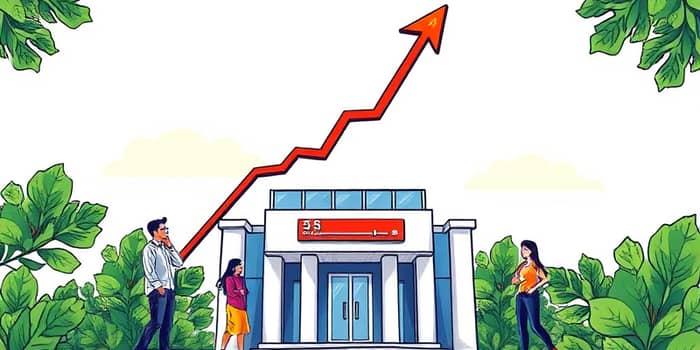
The global financial sector is showing renewed vigor as stronger loan demand emerges in the wake of shifting monetary policies and improving economic metrics. Financial institutions on both sides of the Atlantic report indications that borrowers—from consumers to corporations—are increasingly inclined to take on new financing. This resurgence follows a period of restraint when elevated borrowing costs weighed heavily on credit uptake. Now, as central banks signal a departure from restrictive measures, banks and lending platforms are preparing operationally and strategically to capture this wave of demand. Stakeholders across the value chain stand to benefit from this moment of transition and opportunity.
In the United States and Europe, central banks have pivoted decisively into a turn toward more affordable borrowing. The Federal Reserve initiated a 0.5% rate cut in September 2024, while the European Central Bank followed suit with its own easing measures. These decisions mark a clear prolonged rate-easing cycle boosting credit growth. Lower benchmark rates reduce funding costs for banks, enabling them to lower lending rates and underwrite a broader spectrum of loans. Over time, this shift is expected to underpin a sustained recovery in credit markets.
Economic forecasts reinforce this momentum. Europe is on track for a 1.4% GDP rise in 2025, propelled by Germany’s industrial rebound and easing inflationary pressures. In the United States, indicators point toward a soft economic landing in 2025, as strong employment and stable GDP growth foster a supportive environment for lending. Consumer sentiment is edging upward, and business investment is regaining footholds in key sectors. Collectively, these dynamics create a backdrop in which banks can more confidently expand loan portfolios and develop products that meet evolving borrower needs.
After a muted 2024, lending growth is poised to accelerate markedly across regions. Forecasts suggest banking sectors will see significant upticks in credit extension, projected at 3.1% in 2025 in Europe and even stronger figures elsewhere. This anticipated surge reflects not only lower rates but also renewed confidence among borrowers and lenders alike. The following table highlights key metrics for loan growth across major markets, illustrating how different regions are set to benefit from the confluence of easing monetary policies and economic recovery.
In Europe, the rebound is led by strong consumer credit growth in Spain and marked improvements in France’s mortgage sector. After a contraction of 0.5% in 2024, French mortgage lending is expected to expand by 3.8% in 2025 and 5.1% in 2026. Meanwhile, consumer credit in France should rise by 4.5% next year and 5.6% in 2026. Market participants attribute this turnaround to services-driven, low energy dependency and the broader industrial recovery underway in Germany.
In the U.S., commercial banks achieved approximately 3% loan growth in 2024, while community banks—such as Bank of Zachary—grew portfolios by 8% despite headwinds. Regional banks are poised to benefit from a steepening yield curve that signals green shoots in loan activity. Total returns for bank loans are forecast at around 7% in 2025, with a yield to maturity near 8.76%, well above pre-2021 levels. This outlook encourages lenders to expand credit offerings.
The recovery in loan demand will not be uniform; it will be shaped by evolving industry trends and borrower needs. Consumer lending is benefiting from an uptick in disposable income and improved affordability. Institutions are leveraging technology to deliver digital experiences and customized products.
Commercial real estate (CRE) and mortgage lending are also on the mend. After feeling the strain of higher rates, demand is set to rebound as property developers and investors seize affordability improves for commercial real estate opportunities. In construction and infrastructure, construction and investment activity increase once financing terms become more favorable, bolstering demand for project financing.
Despite optimism, risks persist. A slight uptick in defaults is possible as economic cycles evolve, and recovery of principal may remain below historical averages. Banks must prioritize prudent credit selection and conservative underwriting to maintain asset quality and protect capital.
Liquidity remains critical. Financial institutions are actively managing portfolios for liquidity, deploying strategies such as loan sales, securitization, and secondary-market origination. By optimizing portfolio mix—focusing on maturity, credit quality, and marketability—banks can ensure flexibility and resilience.
Sentiment among executives and analysts is marked by cautious optimism. While the precise timing and magnitude of further rate cuts remain uncertain, most agree that transformative technology, innovation, and sustainability will be key differentiators. Enhanced risk management frameworks and capital planning will also play crucial roles in shaping performance.
For lenders, borrowers, and investors alike, the months ahead offer a moment to embrace emerging opportunities in lending and position themselves for sustainable growth. Institutions that combine disciplined risk management with agile product development and digital innovation will be best poised to capitalize on the upswing. Borrowers who lock in attractive financing now can finance expansion, invest in transformative projects, or refinance existing liabilities under more benign terms. Ultimately, this renewed vigor in loan markets signals a turning point—one that can reinforce economic resilience and spur lasting prosperity.
References













